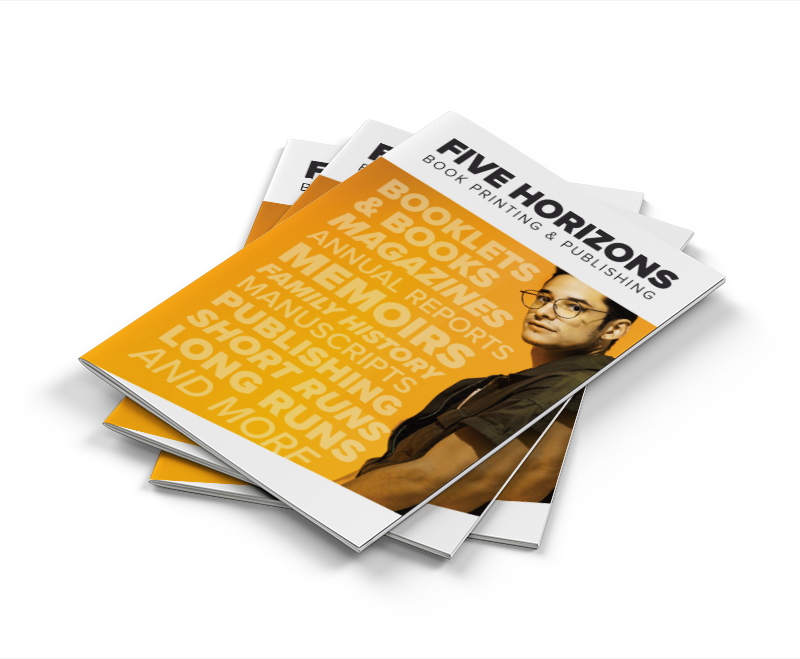






Self-publishing empowers authors to bring their stories to life and connect directly with readers. However, to ensure a professional finish and stand out in a crowded market, quality control is essential in self publish book printing. By implementing rigorous quality control measures, self-published authors can create books that meet industry standards and captivate readers.
At Five Horizons Book Printing, we understand the importance of quality control in self-publishing. Our team of experts helps authors navigate the self-publishing terrain, offering customized solutions to meet their unique requirements. From professional editing to cover design, typesetting, and printing options, we provide comprehensive services that elevate the quality of self-published books.
Join us as we explore the different aspects of quality control in self-publish book printing and uncover the strategies that can help authors achieve a professional finish for their self-published books.
Quality control is a crucial aspect of self-publish book printing that should not be underestimated. It plays a vital role in ensuring that the final product meets the highest standards of professionalism and quality. By implementing effective quality control measures, self-published authors can enhance the overall reading experience for their audience and combat the stigma associated with self-published books.
Self-publishing can be a challenging endeavor, with authors having to navigate through a complex and ever-changing landscape. From manuscript preparation to cover design and distribution, there are numerous factors to consider and potential pitfalls to avoid. Quality control becomes particularly important in this process, as it helps authors maintain control over the final outcome of their work.
The digital publishing era has brought new opportunities and challenges for self-published authors. While it has enabled easier access to publishing platforms, it has also led to an influx of poorly edited and hastily produced books. By implementing quality control measures, authors can ensure that their work stands out in the crowded digital marketplace and maintains its integrity.
One of the main challenges faced by self-published authors is the stigma associated with self-published books. Many readers still have reservations about the quality and credibility of self-published works. However, by prioritizing quality control and producing published book printing that is professionally edited, well-designed, and free of errors, authors can overcome this stigma and gain the trust and respect of their readers.

Professional editing is an essential component of the self-publishing process. Hiring a professional editor is crucial to ensure the quality and coherence of your manuscript. Skilled editors have the expertise to refine your work, improving its literary value and engaging readers with a polished and well-edited book.
There are various types of editing that contribute to the overall refinement of self-published books. Developmental editing focuses on the structure, plot, and character development of the manuscript. Copyediting involves reviewing and editing for grammar, spelling, and punctuation errors. Proofreading is the final step, ensuring that the book is error-free and ready for publication.
By investing in professional editing services, self-published authors can elevate the quality of their work and establish credibility with readers. Professional editors provide valuable feedback and suggestions to enhance your writing, helping you create a cohesive and engaging story.
The process of turning a manuscript into a published book involves several important stages that require careful attention and quality control. In this section, we will explore each step of this journey and highlight the key considerations for authors.
The initial assessment of the manuscript is a critical stage in ensuring a compelling and well-structured book. Authors should carefully review their work or seek professional manuscript assessment services to identify areas that may require revisions or improvements. This thorough evaluation helps to refine the content and enhance its overall quality.
Creating a visually impactful book involves thoughtful cover design and typesetting. The cover design serves as the first point of contact for readers, and it should capture their attention and convey the essence of the book. Additionally, typesetting plays a crucial role in enhancing readability and providing a visually pleasing experience. Authors should consider collaborating with professional designers and typesetters to ensure their book stands out among competitors.
Print-on-demand (POD) is a cost-effective printing model that allows authors to print books as they are ordered, eliminating the need for large print runs and excessive inventory. Authors should familiarize themselves with the concept of POD and explore the various distribution channels available to reach their target audience effectively. By leveraging print-on-demand and distribution channels, authors can streamline the process of getting their books into the hands of readers.
Book cover design is a crucial aspect of self-publish book printing that should not be overlooked. The cover of a book plays a significant role in creating the first impression and attracting potential readers. A visually appealing and well-designed cover can pique the curiosity and interest of readers, prompting them to pick up the book and explore its contents.
First impressions are vital in the world of books. When a reader comes across a book for the first time, the cover is often the first element they notice. A compelling cover design can evoke emotions, convey the genre and tone of the story, and create a sense of intrigue. It sets the stage for the reading experience and can impact whether a potential reader decides to give the book a chance or pass it by.
Creating a standout book cover requires the expertise and creativity of professional designers. Collaborating with designers who specialize in book cover design can provide self-published authors with valuable insights and fresh perspectives. Designers can bring the essence of the book to life through visually appealing graphics, typography, and color schemes, ensuring that the cover effectively represents the content within.
Self-publishers have the freedom to customize their book covers to align with their personal vision and branding. From font selection to image placement, self-publishers can make choices that reflect the unique identity of their book and capture their target audience’s attention. Customization options also allow self-publishers to differentiate their books in a crowded market and make them stand out among their competitors.
| Benefits of Collaborating with | Designers for Book Cover Design |
|---|---|
| 1. | Access to professional expertise and creativity |
| 2. | Ability to convey the essence of the book through design |
| 3. | Creation of visually appealing graphics and typography |
| 4. | Efficient use of color schemes to attract readers |
| 5. | Opportunity to customize the cover and align with personal vision |

The internal layout and typesetting of a book are essential factors in creating a reader-friendly experience. A well-designed internal layout and thoughtful typesetting techniques can greatly enhance the readability and engagement of the book.
When it comes to the internal layout, there are several elements to consider. Font selection, for example, plays a significant role in readability. Choosing a font that is easy on the eyes and appropriate for the genre and theme of the book is crucial. Additionally, proper spacing between lines and paragraphs can improve readability and prevent the text from looking cluttered.
Typesetting involves formatting the text on the page, including alignment, indentation, and paragraph breaks. Consistency in these elements can create a cohesive and visually appealing reading experience. Breaking up lengthy chunks of text with subheadings, bullet points, or numbered lists can also make the content more digestible and reader-friendly.
By prioritizing the internal layout and typesetting of their books, self-published authors can create a professional and aesthetically pleasing finished product. This attention to detail can greatly enhance the reader’s experience and leave a positive impression.
Proofreading plays a critical role in the publishing process, ensuring a polished and error-free final product. It is an essential step in preventing costly errors that may arise post-production. By conducting thorough proofreading, self-published authors can uphold the highest standards of quality.
One of the primary purposes of proofreading is to prevent costly errors that can occur after the production process. By meticulously reviewing the manuscript for spelling, grammar, punctuation, and formatting mistakes, authors can catch and correct any issues that may undermine the professionalism and readability of their book.
Proofreading also involves checking for inconsistencies, such as contradictory information or plot holes, which can significantly impact the reader’s overall experience. By conducting a thorough proofreading process, authors can ensure a seamless and enjoyable reading journey for their audience.
Proofreading is a vital quality assurance practice that contributes to the overall professionalism and integrity of self-published books. It ensures that the book meets industry standards and showcases the author’s commitment to delivering a high-quality product.
Proofreading involves not only checking for errors but also reviewing the overall flow and coherence of the text. It helps to identify areas where the writing can be improved, such as tightening sentences, clarifying statements, and enhancing the overall readability. By incorporating proofreading as part of the publishing process, authors can elevate the literary value of their work.
Overlooking proofreading can have serious implications for self-published authors. Errors and inconsistencies in the final product can significantly impact the author’s reputation and credibility. Readers may perceive a lack of professionalism and become hesitant to engage with future works by the author.
By investing time and effort into thorough proofreading, authors can instill confidence in their readers and demonstrate their commitment to delivering a quality reading experience. Proofreading is a vital step in minimizing any potential negative implications and ensuring that the final book reflects the author’s best work.
| Advantages of Proofreading | Disadvantages of Overlooking Proofreading |
|---|---|
| Ensures a polished and error-free final product | Undermines author’s professionalism and credibility |
| Enhances the overall readability and coherence of the book | Deters readers from engaging with future works |
| Contributes to the author’s reputation as a professional writer | Creates a negative reading experience for the audience |

When it comes to self-publishing, choosing the right printing options is essential to ensure the quality and overall presentation of your book. By making informed decisions, you can achieve a professional and visually appealing final product that meets the expectations of readers.
Here are some factors to consider when selecting printing options:
By considering these factors and exploring the various printing options available, you can ensure that your self-published book has the print quality and presentation that will captivate readers and leave a lasting impression. Many book printing companies have a tendencey to quote the lowest quality specs for the cheapest price. For your own book, choose a book printing company that provides value wihout compromisng quality. Online Self Publishing is a difficult landscape to navigate. No matter if it is a Novel, Children’s Books, Photo Books or a first draft, check the reviews and ask for samples.
In order to generate maximum exposure for your self-published book, marketing plays a crucial role. Building an engaging author platform is an essential step to connect with readers and promote your book effectively. By establishing your presence online and offline, you can reach your target audience and create a buzz around your book.
An author platform is your online presence, consisting of your website, blog, social media profiles, and email list. It serves as the central hub for your book promotion efforts and allows you to engage directly with your readers. By sharing valuable content related to your book, interacting with your audience, and building a community, you can establish yourself as an authority in your genre and attract potential readers.
Digital marketing is a powerful tool for self-published authors. Online marketing strategies such as search engine optimization (SEO), social media advertising, email marketing, and content marketing can help you reach a wider audience and get your book in front of potential readers. Offline marketing strategies, such as attending book fairs, organizing author events, and collaborating with local bookstores, can also be effective in generating buzz and attracting readers.
Reader feedback is invaluable for self-published authors. It provides insights into what works and what can be improved in your book and marketing efforts. By actively seeking and incorporating reader feedback, you can refine your writing style, cover design, marketing messaging, and overall self-publishing approach. This continuous improvement process helps you deliver a better reading experience and build a loyal reader base.

Ensuring a professional finish in self-publishing requires an ongoing commitment to quality. By prioritizing quality control throughout the process, self-published authors can create a positive and lasting impression on their readers. Continuous improvement and refinement are key to elevating the self-publishing experience.
One way to enhance the self-publishing journey is by partnering with Five Horizons Book Printing. This reputable company offers high-quality printing services and customized solutions for self-published authors. By collaborating with Five Horizons, authors can access a range of printing options and expert guidance to achieve a premium finish for their books.
Through a combination of professional editing, meticulous proofreading, and thoughtful design choices, self-published authors can elevate the literary value of their work. By choosing the right printing options and effectively marketing their books, authors can reach their target audience and generate maximum exposure.
Self-publishing is an empowering and rewarding process, and by embracing the ongoing commitment to quality, authors can create self-published books that stand out in the market. With the support of Five Horizons Book Printing and a dedication to excellence, self-published authors can take their literary dreams to new heights.
Quality control in self-publish book printing involves implementing measures to ensure a professional finish and maintain the integrity of self-published books. It includes various steps and considerations throughout the self-publishing process to ensure high-quality printing and a positive reader experience.
Quality control is important in self-publishing to combat the stigma associated with self-published books and create a positive impression among readers. It helps authors elevate the professionalism of their work, enhance the literary value, and engage readers with a polished and well-refined book.
Self-published authors can maintain integrity in the digital publishing era by implementing quality control measures. This includes investing in professional editing services, refining the manuscript through assessment and revisions, and ensuring visually impactful cover design and typesetting. By prioritizing quality at every stage, authors can create a professional and well-crafted book.
Self-published authors can combat the stigma associated with self-published books by focusing on quality control throughout the self-publishing process. By investing in professional editing, refining the manuscript, and creating visually appealing covers and layouts, authors can produce high-quality books that rival traditionally published works.
Professional editing is a non-negotiable step in self-publishing because it ensures the quality and coherence of the manuscript. It includes various types of editing, such as developmental editing, copyediting, and proofreading, which contribute to the refinement and overall professionalism of self-published books.
The journey from manuscript to a published book involves several stages. This includes the initial manuscript assessment and revisions to refine the content, cover design and typesetting for visual impact, and understanding print-on-demand and distribution channels to effectively reach the target audience.
Book cover design is crucial in self-publishing as it creates a strong first impression and attracts potential readers. A well-designed cover effectively conveys the essence of the book, and by collaborating with professional designers and utilizing customization options, self-published authors can create standout covers that make their books visually appealing and unique.
The internal layout and typesetting of a book play a crucial role in providing a reader-friendly experience. Well-designed layouts and effective typesetting techniques enhance readability and engagement. Authors should consider elements such as font selection, spacing, and alignment to create a seamless reading experience and a professionally crafted book.
Proofreading is a critical step in the publishing process to ensure a polished and error-free final product. It serves as a quality assurance practice, preventing costly errors that may arise post-production. By prioritizing proofreading, authors can enhance the overall professionalism and integrity of their self-published books.
When choosing printing options, self-published authors should consider factors such as paper stocks, binding methods, and print finishes. Making informed decisions about these options ensures the print quality and overall presentation of their books, meeting the expectations of readers and enhancing the self-publishing experience.
Self-published authors can effectively market their books by building an engaging author platform to connect with readers. Leveraging online and offline marketing strategies, such as social media promotion and book signings, helps reach the target audience. Incorporating reader feedback for continuous improvement also enhances the overall self-publishing experience.
Copyright © 2025 Five Horizons. All Rights Reserved.